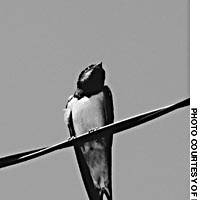* Japanese name: Tsubame
* Scientific name: Hirundo rustica
* Description: A common and easily recognizable bird, barn swallows have long, pointed wings and deeply forked tails. The feathers on the back and wings are a metallic dark blue; the underside is white or cream. The face is scarlet red. Both sexes look similar, although males (79-106 mm) are longer than females (68-84 mm). Males also have longer tail streamers.
* Where to find them: Barn swallows breed all over Japan during the summer, arriving in April from their winter stay in Southeast Asia, including Indonesia and Micronesia. Swallows construct bowl-shaped nests from mud mixed with saliva and grass, often in caves and under the eaves of barns and houses. (In Japan it is considered good luck to have a swallow nesting in your house.) Swallows prefer open habitats with lots of room for aerial maneuvers.
* Food: Insects, mainly bluebottles and horseflies. Swallows catch insects on the go, flying fast and low over the ground and water. They owe their agility and maneuverability in large part to their fork-shaped tails. While flies make up the majority of their diet, they also eat other insects, including beetles, mayflies, aphids, moths and flying ants.
* Special features: The female lays four to six small whitish eggs and incubates them for about 15 days while the male feeds her. In North America, males share incubation duties, but in Europe females do it themselves. Both parents feed the young once they hatch, and it takes about another 15 days before the nestlings fledge and are ready to leave the nest.
The females prefer males with longer tails, as they apparently advertise the good genes of their owners. Such males start breeding earlier and have more nestlings. Long-tailed males also have less parasitic mites and live longer. While females stuck with shorter-tailed males might not be getting good genes, however, short-tailed males provide more help in the nest.
15 mins ago



















With your current subscription plan you can comment on stories. However, before writing your first comment, please create a display name in the Profile section of your subscriber account page.